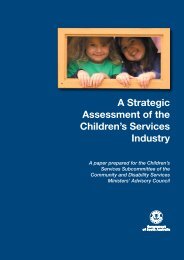Global Study On Child Poverty And Disparities (PDF) - Social Policy ...
Global Study On Child Poverty And Disparities (PDF) - Social Policy ...
Global Study On Child Poverty And Disparities (PDF) - Social Policy ...
Create successful ePaper yourself
Turn your PDF publications into a flip-book with our unique Google optimized e-Paper software.
Table 3.1: <strong>Child</strong> nutrition outcomes and their correlates, 2007<br />
(<strong>Child</strong>ren age 0-59 months who are severely or moderately undernourished)<br />
Underweight Stunting Wasting Obesity<br />
Weight Weight Height Height Weight Weight Weight<br />
for age: for age: for age: for age: for height: for height: for height:<br />
Background<br />
% below % below % below % below % below % below % above<br />
characteristics<br />
-2 SD* -3 SD -2 SD** -3 SD* -2 SD*** -3 SD +2 SD<br />
Number<br />
of<br />
children<br />
Sex Male 18.3 1.9 23.4 7.0 7.0 1.1 2.4 620<br />
Female 13.4 2.5 16.6 6.6 5.9 1.6 2.3 580<br />
Region Tafea 11.4 1.7 17.7 6.9 1.1 0.6 2.9 175<br />
Shefa 12.7 0.6 16.5 5.1 5.7 0.0 1.9 158<br />
Malampa 15.7 2.8 23.1 6.5 4.6 0.9 1.9 108<br />
Penama 21.8 0.8 21.0 3.4 7.6 2.5 3.4 119<br />
Sanma 19.6 3.6 22.3 8.9 11.6 1.8 0.9 112<br />
Torba 19.0 4.0 15.1 3.2 8.7 0.0 0.8 126<br />
Port Vila 13.3 3.2 22.3 10.4 7.6 3.2 3.6 278<br />
Luganville 23.4 1.6 16.9 7.3 9.7 0.8 3.2 124<br />
Residence Urban 15.2 2.9 21.3 9.8 7.9 2.8 3.5 402<br />
Rural 16.1 2.0 19.9 6.1 6.1 1.0 2.1 798<br />
Age < 6 months 2.2 0.0 3.0 0.0 0.4 0.0 3.0 80<br />
6-11 months 6.4 0.9 4.1 1.8 6.3 1.8 4.5 137<br />
12-23 months 26.0 3.4 25.9 7.3 14.3 2.4 1.9 275<br />
24-35 months 17.9 2.4 20.5 7.9 4.1 0.5 2.2 244<br />
36-47 months 11.3 1.4 20.9 7.4 3.9 1.3 0.0 253<br />
48-59 months 16.8 2.9 28.7 10.2 3.7 1.2 4.2 211<br />
Mother's<br />
education<br />
None 21.0 3.1 26.9 12.1 7.9 1.9 5.8 90<br />
Primary 17.3 2.5 20.1 7.0 6.5 1.5 1.9 709<br />
Secondary 11.6 1.3 18.1 4.9 5.9 0.9 2.2 399<br />
Non-standard (*) (*) (*) (*) (*) (*) (*) 2<br />
Wealth index<br />
quintiles<br />
Q1 (poorest) 18.1 4.6 23.2 9.9 6.1 1.0 2.3 226<br />
Q2 20.5 2.0 18.4 5.0 9.0 0.8 0.9 233<br />
Source: MICS 2007.* MICS indicator 6, MDG indicator 4; ** MICS indicator 7; *** MICS indicator 8; (*) per cent count has been<br />
suppressed as the Figure is based on fewer than 25 unweighted cases; § three missing cases.<br />
There is a broadly consistent age pattern across<br />
measures of nutritional status: children under six<br />
months have the lowest rates of poor nutrition<br />
status for all indices; and generally, a higher<br />
proportion of children age 12-23 months are<br />
undernourished, in comparison to those who<br />
are younger and older than this age range,<br />
except for severe stunting where older age<br />
groups, particularly those age 48 to 59 months,<br />
are more likely to experience problems. The<br />
better outcomes for children under six months<br />
is likely to be due to adequate nutrition during<br />
breastfeeding, with this then declining from the<br />
age at which many children cease to be breastfed<br />
and are potentially exposed to contamination in<br />
water, food and the environment, or inadequate<br />
complementary feeding (GoV, 2007a).<br />
Gender outcomes also show a mixed pattern,<br />
with boys more likely to be moderately<br />
underweight, stunted or wasted, but generally<br />
experiencing less severe nutrition deprivation,<br />
except stunting.<br />
Analysis<br />
As noted earlier, most of the rural population<br />
relies on subsistence agriculture. This appears to<br />
provide adequate food security for the population,<br />
although some families may not consume<br />
adequate protein. There is also fishing and<br />
poultry rearing in traditional subsistence farming.<br />
55
















